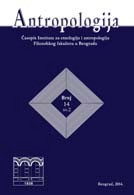ЈЕЗИЧКИ КРАЈОЛИК СРБИЈЕ (ДРУГИ ДЕО): ЖАНРОВСКА ДИГРАФИЈА И СЕМИОТИЗАЦИЈА ПИСAМА
THE LINGUISTIC LANDSCAPE OF SERBIA (PART TWO): GENRE DIGRAPHIA AND SCRIPT SEMIOTIZATION
Author(s): Dejan IvkovićSubject(s): Semiotics / Semiology, South Slavic Languages
Published by: Институт за етнологију и антропологију
Summary/Abstract: This paper presents the second part of the study of the linguistic landscape (LL) of Serbia and digraphia as its main characteristic. In the first part, the study is concerned with perceptions and awareness of alphabet presence in the public sphere among residents of Serbia, that is, the 'subjective' dimension of Serbia's LL. This paper explores its 'objective' dimension, by documenting, analyzing and explaining the processes underlying the use of the two scripts across a range of contexts and situations that sets Serbia's speech community apart from those in other polities in Europe and beyond. The workings of digraphia processes are here described as genre digraphia. More specifically, genre digraphia is defined as a tendency of use of one or the other alphabet in a particular domain/subdomain of language use, or genre: context, content, agency, activity, as well as within a particular spatial and temporal frame. Accordingly, one or the other alphabet would more likely be associated with a particular religious denomenation, political party and/or its ideological proponent(s), setting or type of everyday activity, locale, and historical event or period. Given a range of contexs in which the genre-driven alphabet split is enacted, a multimethodical approach is used (Wodak, 2006), which relies on both quantitative and qualitative approaches. The results of the analysis indicate a high degree of agreement between the perceptions of alphabet presence in selected domains and subdomains of language use and actual presence, thus confirming the main thesis of the study that genre digraphia is the defining feature of the LL of Serbia. In addition, the linkage with the particular domain of language use gives rise to script semiotization: alphabet becomes an index – a type of semiotic sign which points to the location, relation, etc. of signifieds. Alphabet indexicality is thus instantiated in a specific context, both the immediate context of situation and the broader context of culture. In this regard, an alphabet becomes an index of religion, identity and nationhood, commodification, presss tabloidization, and internetization, to name a few.
Journal: Antropologija
- Issue Year: 15/2015
- Issue No: 3
- Page Range: 69-99
- Page Count: 31
- Language: Serbian

